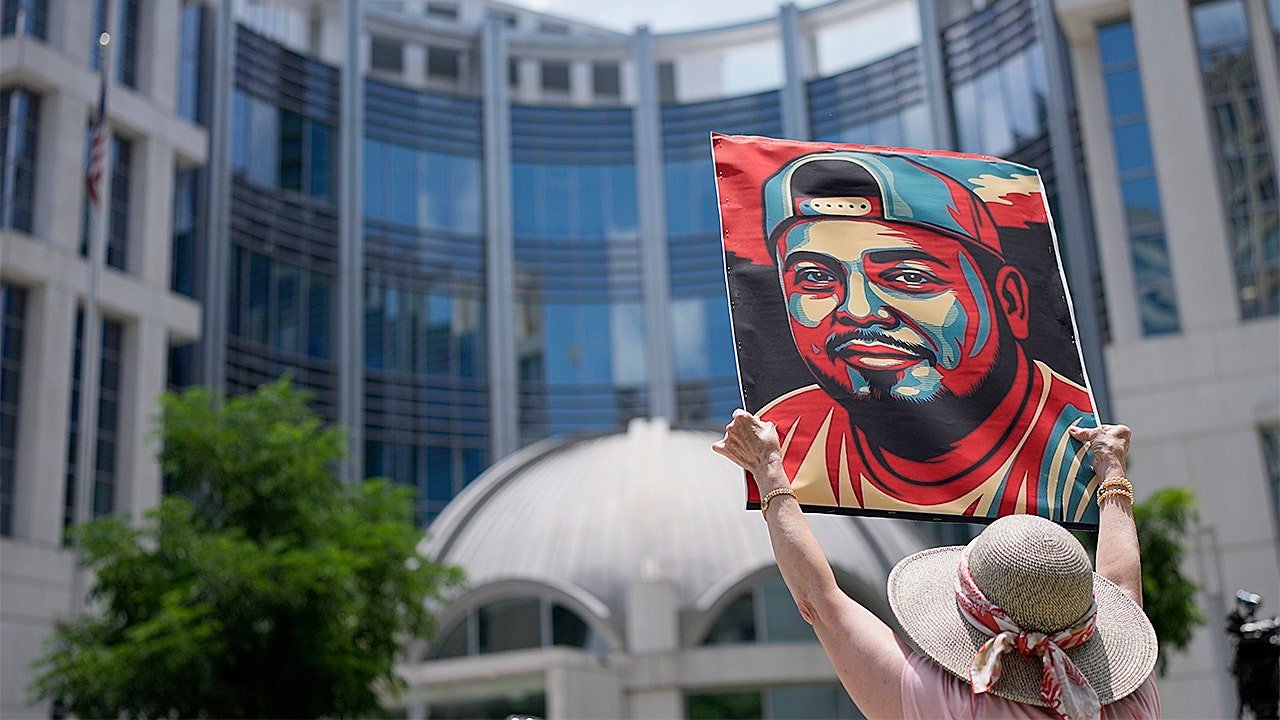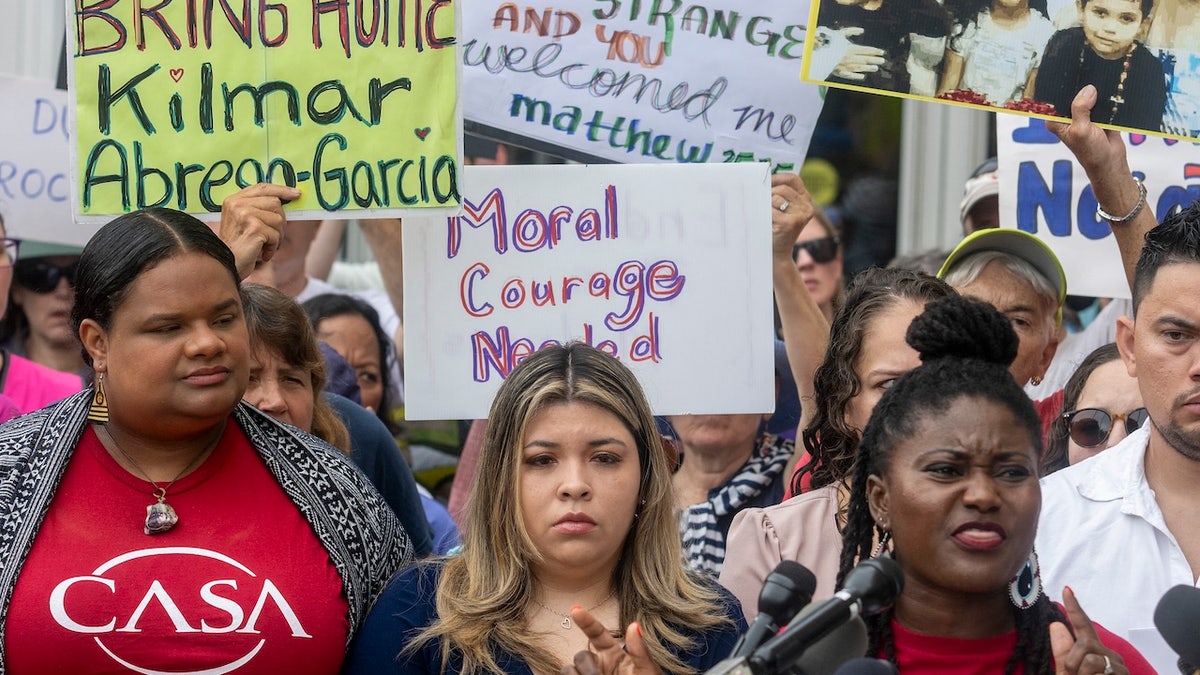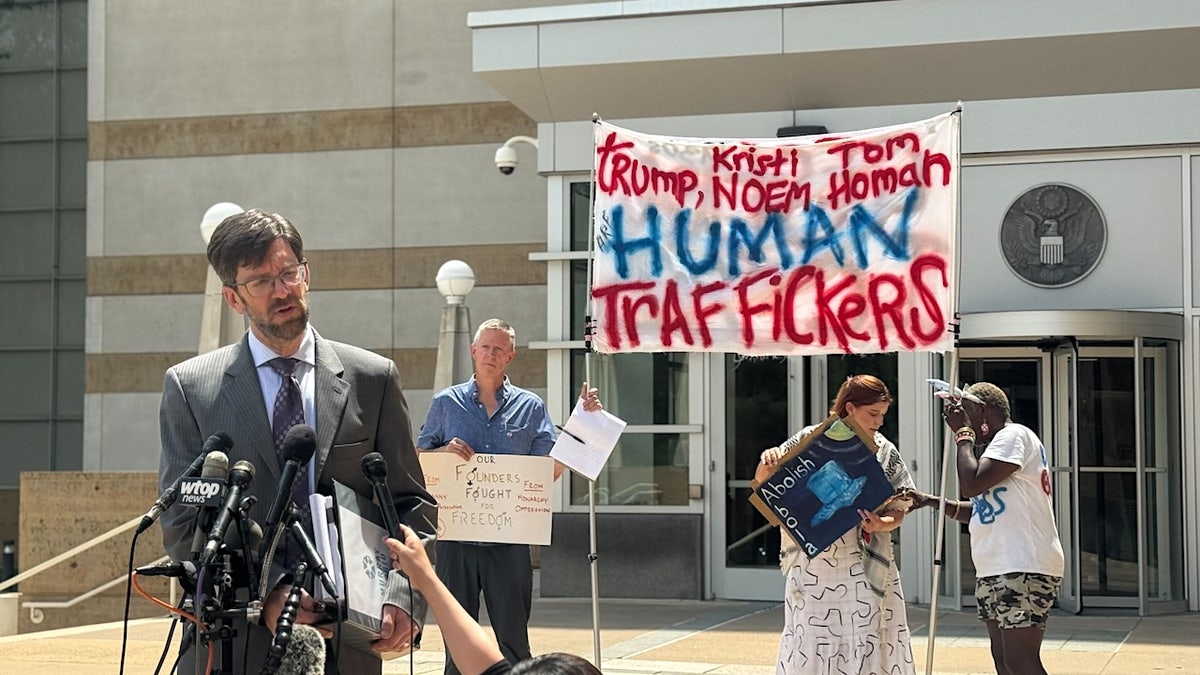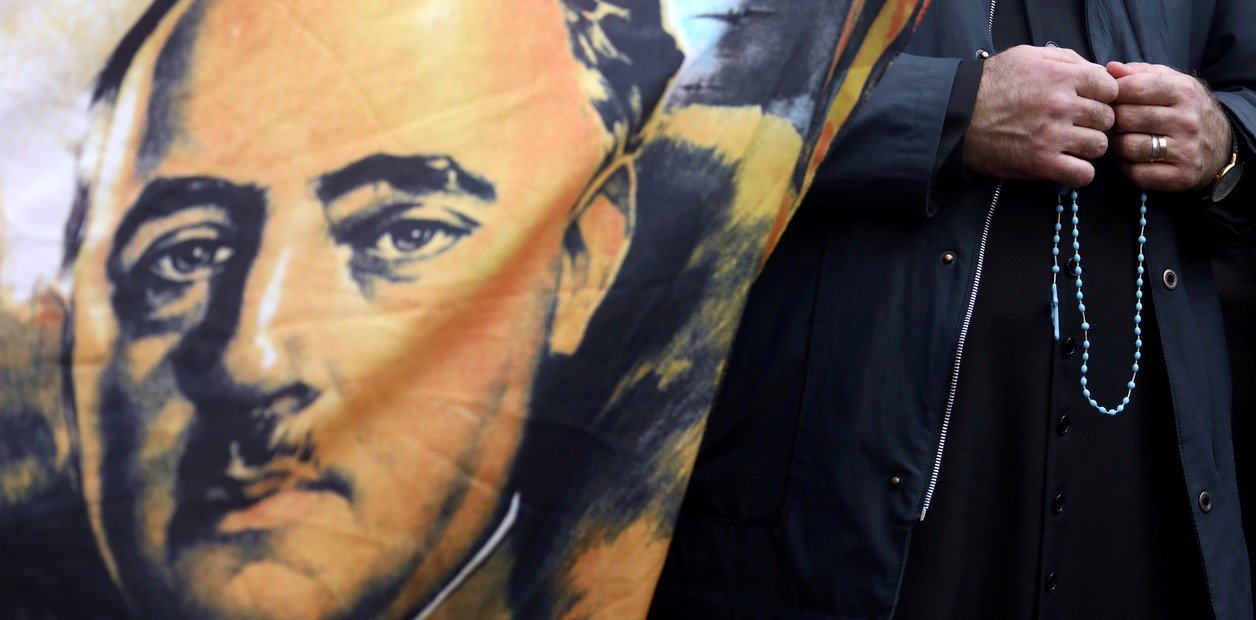INTERNACIONAL
US judge vows to rule ‘soon’ on Abrego Garcia’s fate after marathon hearing

NEWYou can now listen to Fox News articles!
GREENBELT, MD— A federal judge in Maryland on Friday vowed to issue an order «as soon as possible» in a case involving the legal status of Salvadorian migrant Kilmar Abrego Garcia and the Trump administration’s plans to deport him from the U.S. to a third country within days — capping an extraordinary marathon hearing in his case that stretched for nearly seven hours — and has dominated headlines and federal court dockets for as many months.
U.S. District Judge Paula Xinis adjourned the court Friday evening with a promise to order on the matter as quickly as possible. Much of the hearing, however, was punctuated by incredulous objections from Xinis and frequent requests to «sidebar» with lawyers arguing both sides of the case.
For Xinis, a judge who has presided over various iterations of Abrego’s civil case since March, the frequent pauses were a bit of an abberration, which she acknowledged.
«I’ve always been a proponent of smooth jazz,» she quipped.
Certain portions of the day went far less smoothly. Xinis upbraided the Trump administration for its failure to produce a witness for the court to testify about what steps it had taken to facilitate Abrego Garcia’s deportation to a third country, describing the official who appeared on the stand as a witness «who knows less than nothing» about the case, and the countries they are considering removing him to.
«This appears to be in direct contravention of the court,» she noted pointedly, shortly before adjourning for the day.
ABREGO GARCIA REMAINS IN US FOR NOW AS JUDGE TAKES CASE UNDER ADVISEMENT
Kilmar Abrego Garcia (R) and his wife Jennifer Vasquez Sura (L) attend a prayer vigil before he enters a U.S. Immigration and Customs Enforcement (ICE) field office on August 25, 2025 in Baltimore, Maryland. ( Anna Moneymaker/Getty Images)
Xinis had ordered the evidentiary hearing Monday, with the stated goal of evaluating a request from Abrego Garcia’s lawyers, that he be released from immigration detention pending further action in his case, and to question a Trump administration official with «first-hand» knowledge of the government’s efforts to facilitate his deportation to the third country of Eswatini, where Trump officials said they intend to send him.
Still, the hearing was much more notable for what it failed to produce than what it did. Judge Xinis struggled to clarify seemingly contradictory statements and testimony from Trump officials, including what countries agreed or did not agree to accept Abrego Garcia, and when.
Lawyers for the Trump administration acknowledged to Xinis that they had previously identified three African countries — Uganda, Ghana, and Eswatini— as suitable third country locations to deport Abrego Garcia, pending dissolution of her emergency order keeping him in the U.S.
But they mistakenly represented the positions of both Ghana and Eswatini. As of this writing, none of the three governments mentioned agreed to accept Abrego Garcia.
Xinis honed in on this detail Friday evening.
«Now that we know Costa Rica is on the table, have there been any conversations about removing him [there]?» she asked Justice Department lawyer Drew Ensign, who said that there had not been.
«Why not?» Xinis pressed. «You don’t want him in the country — you’ve said that,» she said, referring more broadly to the views of the the Trump administration. «You have a country that will take him. You have a plaintiff who says ‘I’ll go there.’»
That the government is still pressing for other nations to accept him, she said, is a notion that is a bit «hard to swallow.»
‘WOEFULLY INSUFFICIENT’: US JUDGE REAMS TRUMP ADMIN FOR DAYS-LATE DEPORTATION INFO

The wife of Kilmar Abrego Garcia, Jennifer Vasquez Sura, stands with demonstrators as they rally in support of Garcia outside federal court during a hearing in Greenbelt, Maryland. (Jim Watson/AFP via Getty) (Getty Images)
Many of the crucial details emerged after hours of grueling questioning with John Schultz, the deputy assistant director of ICE’s Enforcement and Removal Operations, whom the government produced as its witness.
Despite his 20 years of experience at DHS, he appeared to know little about the case in question. He failed to answer most of the questions Xinis asked about the government’s plans to deport Abrego Garcia — including basic questions on who within DHS’s ranks had been assigned to handle Abrego Garcia’s case, and the status of various requests for deportation and communications with the countries it had identified.
Asked if he had been involved at all in Abrego Garcia’s case prior to Tuesday, Schultz said only that he «looked into his case in March,» but could not recall «in what capacity.»
Trump officials also told Xinis during court Friday that Eswatini’s government had initially declined to accept Abrego Garcia, but that they are currently having «additional discussions» on the matter and had not reached consensus.
Should Eswatini’s government agree to take Abrego Garcia, Trump officials said, they could facilitate a plane to transport him «within 72 hours,» pending Xinis’s dissolving of her court order requiring Abrego Garcia be kept in the continental U.S.
The other two countries, Uganda and Ghana, were much clearer in their denials.
TRUMP ADMINISTRATION ASKS SUPREME COURT TO REVIEW EL SALVADOR DEPORTATION FLIGHT CASE
Ghana’s foreign minister, Sam Okudzeto Ablakwa, said on social media Friday morning that his country rejected the U.S. request to accept Abrego Garcia, something he said they «directly and unambiguously conveyed to U.S. authorities.»
Abrego Garcia’s lawyer, Andrew Rossman, pointed to the lack of assurances from the three African countries, including the two who have rejected his claim outright.
The government’s goal, Rossman argued, has been to «to identify a series of countries that bear no connection to Abrego Garcia and that have not indicated any willingness to take him.»

Abrego Garcia’s attorneys speak to reporters outside the U.S. District Court in Greenbelt, Maryland, in July. (Breanne Deppisch/Fox News Digital) (Breanne Deppisch/Fox News Digital)
Rather, they argued, he should be sent to Costa Rica, the country DHS officials originally offered to send him to in coordination with a guilty plea in a separate criminal case in Nashville, where he was charged with two counts of smuggling.
Hours after he declined the plea offer, the government sent his lawyers a notice of removal to Uganda. Despite the language of the notice, Uganda’s government had not yet been asked to take Abrego Garcia, let alone agree to it. That detail was one of many unearthed, laboriously, over the course of many hours Friday.
Lawyers for Abrego Garcia, meanwhile, told the court he is «willing and able to board a plane immediately» to go to Costa Rica, if ICE agrees to send him there.
His attorney, Andrew Rossman, argued that the court should order his release from immigration detention otherwise, arguing that «the government has not and is not currently detaining Mr. Abrego for purposes of effectuating his lawful removal,» but rather as a means of punishment.
The government of Costa Rica agreed to accept Abrego Garcia and outlined certain assurances it provided the U.S. in writing, including granting him refugee status there, and promises not to «refoul» him, or re-deport him to his home country of El Salvador, in keeping with an immigration judge’s 2019 court order.
100 DAYS OF INJUNCTIONS, TRIALS AND ‘TEFLON DON’: TRUMP SECOND TERM MEETS ITS BIGGEST TESTS IN COURT
Xinis, for her part, appeared sympathetic to that view.
She also expressed new frustration with the Trump administration’s lawyers, whom she noted had now twice failed to provide the court with a witness who could speak to Abrego Garcia’s case.
«Prior to Monday, what efforts did the government make to find a third country that would accept Abrego?» Xinis asked Trump administration officials at one point during the hearing.
As they struggled to answer, she noted in response, «That’s very troubling to me.»
Lawyers for the Trump administration are free to appeal any order from Judge Xinis to the U.S. Court of Appeals for the Fourth Circuit, as DOJ’s Ensign indicated they might do shortly before court adjourned.
Xinis warned later on that the government, in her view, had little margin for error.
CLICK HERE TO GET THE FOX NEWS APP
«I’m trying really hard to give you the benefit of the doubt,» she told Ensign. But at this point, it’s «getting close to «three strikes, you’re out.»
donald trump,politics,national security,migrant crime,supreme court,federal courts
INTERNACIONAL
Sólo los separó la muerte: la madre de Borges, sobreprotectora e inspiradora

Borges vivió con su madre casi toda su vida, hasta los noventa y nueve años de ella y setenta y seis de él. Salvo su breve y fallido matrimonio con Elsa Astete, gestionado por la propia Leonor, Borges sólo se separó de ella cuando ella murió, es decir, nunca por propia voluntad. Como dijo con acierto el coleccionista y biógrafo Alejandro Vaccaro, Borges tenía un matrimonio con su madre. Sobreprotectora y quizás involuntariamente castradora, Leonor Rita Acevedo Suárez estuvo omnipresente en la vida de su hijo y está omniausente en sus textos, salvo una sola referencia directa, en su texto quizás más hermoso.
Leonor Acevedo vivió casi cien años en los que el mundo y la Argentina se transformaron por completo, y ella, joven lectora de la elite criolla, le transmitió a su hijo las memorias de la Buenos Aires del siglo XIX (tierra mítica del escritor), la inquietud por lo sagrado y el respeto por el peso de los ancestros. Pero, además, fue la mujer que le organizó la vida cotidiana y fue la manager de su carrera profesional. No sólo le hacía los nudos de las corbatas y le organizaba la vida doméstica: también se hizo traductora a los cincuenta años para ayudarlo a él y, cuando se produjo la Revolución Libertadora, hizo lobby para que su hijo tuviera en sus últimos dieciocho años de vida activa un puesto cómodo que le garantizara prestigio y un ingreso sólido: el de Director de la Biblioteca Nacional. También le buscó sin éxito otra mujer que lo cuidara a su muerte y controló sus amoríos platónicos, sobre todo el que tuvo con la peligrosa Estela Canto; le dio algunas ideas (dudosas) para sus cuentos y le pidió que dejara de escribir sobre guarangos, un tema que le recordaba las correrías de su marido por los bajos fondos y la bohemia.

El libro Memorias de Leonor Acevedo de Borges, puntillosamente editado por Martín Hadis en base a transcripciones de conversaciones que una anciana Leonor tuvo con Alicia Jurado y a muchas de sus cartas, es un testimonio riquísimo de esta testigo de un largo siglo porteño, una mujer sagaz y leída de su clase, que enviudó bastante joven y crio a dos de los grandes artistas del siglo XX argentino, Jorge Luis y su hermana Norah, pintora. Es un libro que en fragmentos arma un fresco histórico de Buenos Aires, y en el que se escucha, vivo y honesto, el material que Borges usó para la creación de su mitología de la ciudad: desde los “coches de plaza” cruciales en el cuento El Sur hasta las memorias de las batallas de Cepeda y de Pavón recreadas en el poema sobre su abuelo Isodoro, el padre de Leonor. También, la anciana madre desidealiza hechos y personas que Borges idealiza en su literatura: de Macedonio Fernández dice que “estaba más loco que una cabra”, y al mes de prisión domiciliaria que padeció en 1948, por manifestarse en contra de Perón, que su hijo convertirá en un acto heroico, lo cuenta casi como una comedia.
El padre de Borges tiene una fama algo mejor que la que tiene su madre: murió cuando Borges era relativamente joven, a los treinta y ocho años, le legó la vocación literaria y la miopía degenerativa, y su muerte inspiró a Borges grandes cuentos de duelo (Tlön Uqbar Orbis Tertius, Funes el memorioso) y, a la vez que lo obligó a trabajar para vivir, lo liberó emocionalmente para lanzarse, justo en el año de su muerte, al raid creativo que lo llevaría a escribir en poco más de diez años Ficciones y El Aleph, los dos libros con los que tocó la gloria.
Borges estaba obsesionado con los hombres, se sabe. Sus cuentos, salvo excepciones deliciosas como El duelo (una historia ¿de amor secreto? entre dos pintoras porteñas, alguna quizás inspirada en Norah) y La viuda Ching, pirata (poética heroína de la retirada) son una matrioshka de duelos de hombres contra hombres.
La palabra “madre” aparece 81 veces en la edición de 1974 de la Obras completas de Borges. La enorme mayoría de ellas son para referirse a las madreselvas o para usos metafóricos (“la historia, madre de la verdad” o “Madre del Libro”). Entre las pocas madres levemente significativas de sus cuentos, están las madres de los gauchos Tadeo Isidoro Cruz e Irineo Funes, de las que se quiere acentuar que son madres solteras de compañeros ocasionales o fruto de relaciones clandestinas con inmigrantes europeos; Borges, inquieto siempre por los muchachos rudos del pasado y del presente, hace a los gauchos de las guerras civiles y a los cuchilleros de las orillas hombres sin padre y sin partido. Muy al pasar, Borges se permite algunas madres significativas: la madre violada de Emma Zunz y la madre reina de Asterión. De entre los cuentos de su primera madurez, sólo en El impostor inverosímil Tom Castro hay una madre con algún matiz de complejidad y protagonismo: Lady Tichborne, que intenta recuperar a un hijo que perdió en un naufragio. “Una madre nunca se equivoca”, escribe Borges en 1933 sobre una madre que a todas luces se equivoca.
En algunos de los cuentos dictados en su vejez, como El indigno o Juan Muraña, Borges se permite darles protagonismo a sus madres. La de El indigno”protege con una astucia a su hijo cobarde y traidor de la amenaza velada de un muchachote, y también desaprueba, como Leonor, el trato de su hijo con la “morralla” (“multitud de gente de escaso valer”, según el diccionario).

Inspirado por José Hernández, autor del Martín Fierro, Borges entendió el poder mitológico de que los protagonistas de sus cuentos criollos fueran hombres de a pie, y parte de su operación fue traducir el Martín Fierro a la ciudad, llevar a los gauchos al arrabal, el territorio mítico y fronterizo en el que Buenos Aires “se desgarraba en suburbios”. Los modelos para esas figuras los recibió en giras por bares y cafés de la Buenos Aires de los años veinte, acompañando a su padre. Una de esas figuras, a la que Borges designó su precursor en el arte de “mirar alrededor”, de hacer poesía urbana con lo cercano, fue Evaristo Carriego, que en el poema Vulgar sinfonía, dedicado a Leonor, había pronosticado el destino literario del niño Jorge Luis:
Y que tu hijo, el niño aquél
de tu orgullo, que ya empieza
a sentir en la cabeza
breves ansias de laurel,
vaya, siguiendo la fiel
ala de la ensoñación,
de una nueva anunciación
a continuar la vendimia
que dará la uva eximia
del vino de la Canción.
La fascinación de su hijo por los hombres violentos no le caía demasiado bien a Leonor. Cuenta el propio Borges que su madre le sugirió una de las líneas finales de su cuento La intrusa: “A trabajar, hermano. Después nos ayudarán los caranchos. Hoy la maté”. Aunque la anécdota suele repetirse como una señal de cuán influyente era Leonor en la obra de su hijo, no hay que creerle mucho a Borges: también puede pensarse que es un final bastante obvio e innecesario, y que quizás su hijo sólo lo incluyó por cariño. Lo cierto es que, después de esa sugerencia, vino la ironía: “Georgie, a partir de ahora te pido que no escribas más sobre estos guarangos”. Leonor tenía más de noventa años para entonces, y Borges, que no le hizo caso, casi setenta.
Uno de los pocos textos en los que la madre aparece referida directamente es El amenazado. Festín para psicoanalistas, el poema hace una lista de los talismanes que podrían proteger al poeta de aquello que lo amenaza, que es el amor: “¿De qué me servirán mis talismanes: el ejercicio de las letras, la vaga erudición, el aprendizaje de las palabras que usó el áspero Norte para cantar sus mares y sus espadas, la serena amistad, las galerías de la Biblioteca, las cosas comunes, los hábitos, el joven amor de mi madre, la sombra militar de mis muertos, la noche intemporal, el sabor del sueño?«
¿Pero quién puede juzgar el lazo misterioso que une a una madre y a un hijo? Lo que sí podemos asegurar es que, sin Leonor, fuente de su mitología porteña y agente de su destino literario, Borges no habría sido Borges.

Suena inverosímil que George le haya dicho “Feliz día, mamá” a esa mujer con la que compartió casi toda su vida. Pero, en cambio, decidió dedicarle sus Obras Completas, su libro inmortal, todo un gesto de agradecimiento para el que encontró, como solía hacerlo, palabras tocadas por su talento divino y que habrán llegado sin duda al corazón de Leonor, finísima lectora. Esa dedicatoria es, tal vez, el texto hermoso que mencionábamos al principio:
Desde entonces me has dado tantas cosas y son tantos los años y los recuerdos. Padre, Norah, los abuelos, tu memoria y en ella la memoria de los mayores—los patios, los esclavos, el aguatero, la carga de los húsares del Perú y el oprobio de Rosas—, tu prisión valerosa, cuando tantos hombres callábamos, las mañanas del Paso del Molino, de Ginebra y de Austin, las compartidas claridades y sombras, tu fresca ancianidad, tu amor a Dickens y a Eça de Queiroz, Madre, vos misma.
Aquí estamos hablando de los dos, et tout le reste est littérature, como escribió, con excelente literatura, Verlaine.
INTERNACIONAL
‘First to fight’: Marine VP JD Vance marks Corps’ 250th as Hegseth says unity, not ‘diversity,’ is strength

NEWYou can now listen to Fox News articles!
Vice President JD Vance joined Marines and sailors at Camp Pendleton in California on Saturday for the 250th anniversary of the U.S. Marine Corps, telling the crowd that the Corps remains ready to fight and ready to win.
The anniversary event included an amphibious assault demonstration on Red Beach, speeches from military leaders and cabinet officials, and a reminder from Vance that he is the first Marine to serve as vice president.
Helicopters roared overhead and amphibious vehicles surged through the surf as Marines charged the beach to open the ceremony. Second Lady Usha Vance accompanied her husband to watch the display while families shaded their eyes and Ospreys thundered overhead.
This year’s ceremony marked a quarter millennium since the Continental Congress first authorized the Marine Corps in 1775.
NEWSOM CLASHES WITH WHITE HOUSE OVER MARINE CORPS ANNIVERSARY CELEBRATION HIGHWAY CLOSURE
Vice President JD Vance speaks during the Marine Corps’ 250th anniversary celebration at Camp Pendleton, Calif., Saturday. (AP Photo/Gregory Bull)
General Eric Smith, Commandant of the Marine Corps, told the crowd that what they were seeing was the sound and look of freedom. He described the Corps as America’s «911 force» and warned that Marines must be ready for whatever comes next.
«The next fight is coming,» he said. «Marines will be ready. Ready to fight. Ready to win.»
The next fight is coming. Marines will be ready. Ready to fight. Ready to win.
«When it matters most, it’s not technology or equipment that wins the day, but the dependability, decisiveness and character of the Marine or sailor who wields it,» Smith said. He ended by thanking families and offering a blessing for their sacrifices.
VP VANCE’S CAMP ACCUSES CALIFORNIA GOV. GAVIN NEWSOM OF DISSEMINATING ‘FAKE NEWS’ AHEAD OF MARINES CELEBRATION

Secretary of War Pete Hegseth delivers remarks during the Marine Corps’ 250th anniversary celebration at Camp Pendleton, Calif., Saturday. (Oliver Contreras/AFP via Getty Images)
Secretary of War Pete Hegseth then delivered one of the day’s most fiery addresses. A combat veteran himself, he told the Marines that the Corps stood strong when others wavered.
«I’m not supposed to say this, really not. But I think you guys might be my favorite,» Hegseth said.
He tied the Corps to the administration’s broader theme of America First, peace through strength, and common sense at every turn. Hegseth reminded the crowd that while many different faces fill the ranks, unity of mission is the true strength of the Corps.
«The truth is, your diversity is not your strength. Never has been. Your strength is in your unity of purpose. It’s in your shared mission. It’s in your oath to the Constitution. It’s the bond that turns individuals into single-minded fighting units. You see, you are set apart. You’re not civilians. You’re devil dogs, leathernecks, United States Marines,» the Secretary said, drawing cheers.
The crowd erupted when Vance took the stage.
«God bless you, Marines,» he began, smiling as chants of «Oorah!» echoed back. He quickly reminded them that he’s the first Marine to hold the office of vice president. «From one Marine to another, thank you for your service,» he said.
«I’ve also got to give a special shout out to the incredible display that we saw earlier today. It made my heart sing,» Vance said. «As your vice president, and it was a testament to the core strength and unbeatable power. It reminded me why I am so proud to have worn the uniform, to be one among your ranks, and to be the very first vice president to have been a United States Marine.»
Vance used his speech to honor heroes, remember the fallen and reflect on his own service. He mentioned Medal of Honor recipient Sgt. Dakota Meyer who served in Afghanistan, Navy corpsman Charles Cram who helped raise the flag at Iwo Jima, and Navy aviator Elmer Royce Williams who survived the longest dogfight in American history.
TRUMP DECLARES ‘REAWAKENING’ OF ‘WARRIOR SPIRIT,’ UNWAVERING SUPPORT FOR MILITARY: ‘I HAVE YOUR BACKS’

Vice President JD Vance raises his fist as helicopters fly over Marines during the Corps’ 250th anniversary celebration at Camp Pendleton, Calif., Saturday. (Mario Tama/Getty Images)
The vice president mixed solemnity with humor that fellow Marines recognized immediately. He joked about the «E-4 Mafia» and shared a story about a gunnery sergeant who once saved him from signing a 22% interest used car loan by steering him to Navy Federal Credit Union.
«That gunny’s leadership didn’t just save me money,» Vance said. «It taught me that Marines look out for each other.»
Vance’s remarks included a particular story from boot camp. Recruits queued for Catholic or Protestant church services and Vance, referring to himself in the third person as, «recruit,» called himself an atheist.
«Get in the Catholic line,» the drill instructor snapped. That punchline, Vance joked, «wouldn’t work in the Biden administration.»
Vance also took aim at Democrats in Congress over the government shutdown, promising that the administration would fight to ensure enlisted Marines are paid.
«We will do everything possible to make sure enlisted Marines get paid,» he said. «Political battles in Washington should not come at the expense of troops and their families.»

Vice President JD Vance speaks with his wife Usha Vance before attending the Marine Corps’ 250th anniversary celebration at Camp Pendleton, Calif., Saturday. (Oliver Contreras/AFP via Getty Images)
He tied the 250th anniversary back to the Corps’ beginnings at Tun Tavern in Philadelphia in 1775. He named battles that define Marine history: from Belleau Wood and Iwo Jima to the Chosin Reservoir, Khe Sanh, Ramadi, Fallujah and Helmand, and told the audience that every generation of the Corps shares the same common purpose.
«Every single person here bleeds Marine Corps green,» Vance said. «It is our common purpose that carries us forward.»
Every single person here bleeds Marine Corps green.
Vance reminded East Coast Marines swatting sand fleas at Parris Island that their bond is the same as those climbing the hills of California. He spoke of his pride in wearing the Corps’ uniform and closed with words that Marines have heard before but welcomed on their birthday.
«Keep kicking a–. Keep taking names. Semper Fidelis, Marines. Happy 250th birthday. God bless you,» he said.
CLICK HERE TO GET THE FOX NEWS APP
The ceremony ended with the roar of the crowd as the day carried reminders of sacrifice, grit and unity.
The Department of War, Navy, and Vance’s office did not immediately respond to Fox News Digital’s request for comment. The Marine Corps offered no further comment to Fox News Digital at this time.
jd vance,marines,pete hegseth,defense,military
INTERNACIONAL
Los últimos días de Francisco Franco, el dictador que marcó a fuego la historia de España

El golpe fallido de 1981
Los vínculos de Franco con el nazismo
El yerno, personaje clave en el tramo final

 CHIMENTOS2 días ago
CHIMENTOS2 días agoLaura Ubfal mostró una escandalosa foto de Mauro Icardi con la hija de Benjamín Vicuña

 POLITICA3 días ago
POLITICA3 días agoFabiola Yañez regresó al país, le restituyeron la custodia policial y busca colegio para su hijo

 CHIMENTOS2 días ago
CHIMENTOS2 días agoSe confirmó de qué murió la famosa actriz Diane Keaton a los 79 años: «Murió a causa de una neumonía»





























